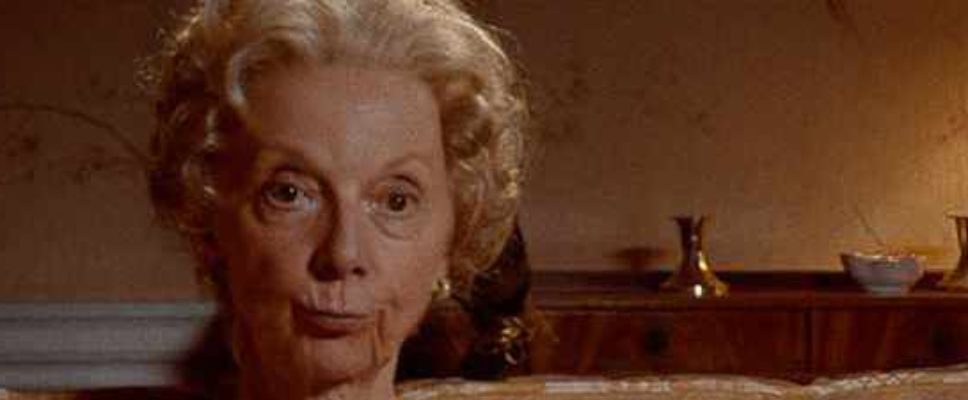Teresa Reviews: “Agatha Christie: A Life in Pictures” (2004)
Fidelity to text: 3 hatchet jobs
![]() It’s reasonably accurate, particularly since every word comes from Agatha’s memoirs or news reports. But the film glossed over a lot.
It’s reasonably accurate, particularly since every word comes from Agatha’s memoirs or news reports. But the film glossed over a lot.
Quality of movie on its own: 3 hatchet jobs
![]() It should have been better since there’s great story material present: romance, death, cheating, fugue states, amnesia, divorce, and a second chance at love. Instead, it was confusing and it dragged.
It should have been better since there’s great story material present: romance, death, cheating, fugue states, amnesia, divorce, and a second chance at love. Instead, it was confusing and it dragged.
Read more of Teresa’s Agatha Christie movie reviews at Peschel Press.
Also, follow Teresa’s discussion of these movies on her podcast.

If you’re going to tell me something is true-to-life, then get the hair color correct. Wigs and dyes are cheap.
Do you see a problem here? If the film had been more involving and less confusing, I wouldn’t focus on some hair stylist’s choice of hair color. Seeing an obvious mistake like this made me wonder how accurate the rest of the movie was. If I’m paying attention to little nits like hair, then the movie failed. Do you think I noticed Agatha’s hair color in the Vanessa Redgrave hatchet job? I did, but they got it right. The Doctor Who episode “The Unicorn and the Wasp” made Agatha a blonde, but it was close enough and the episode involving enough that I didn’t care.
The audience should never pay attention to camera pyrotechnics or notice how the set designer chose the wrong accessories for a period piece or that the time of year doesn’t match the spoken dialog. If the audience does, then the movie failed.
This film doesn’t exactly fail, but it never gelled for me either. It was reverential to the point of being dull. I’d still chose it over the Vanessa Redgrave horror, but then I’d chose virtually any Agatha Christie film over the Vanessa Redgrave horror.
Let’s start with the structure. I can handle flashbacks. But flashbacks within flashbacks get confusing, especially when I’m having trouble understanding the dialog. We move forward in time to when Agatha was 72. She’s at the tenth anniversary party for her play The Mousetrap. The opening scenes show the cake, with some very nice rolled fondant work in both mice and lettering. You see what I mean? I shouldn’t be noticing skillful fondant work on a cake! If I’m noticing the cake, then there must not be any plot!
Anyway. Agatha agrees to a rare interview for the occasion. Reporters ask questions and she reminisces. We swing back in time to her girlhood and young womanhood as needed. Back and forth, back and forth, and then sometimes sideways into the headshrinker’s office. The shrink is trying to get Agatha to figure out why she lost her memory and ended up in some spa in Harrogate.
 I kept noticing the goldfish in the bowl on the table and wondering why the goldfish stuck to the bottom of the bowl instead of swimming around more. Was the water that dirty?
I kept noticing the goldfish in the bowl on the table and wondering why the goldfish stuck to the bottom of the bowl instead of swimming around more. Was the water that dirty?
Darn it. I lost track of the plot again.


No details were given, other than Archie was a narcissist who didn’t like being around anyone ill or unhappy. Agatha’s mother died in 1926, Agatha was distraught, and Archie threw fuel on the fire by demanding a divorce because Agatha wasn’t giving him the attention he thought he deserved and he didn’t want to be around a sad woman. No wonder she went crazy.
But as I said, the film’s chronology was weird, back and forth and sideways. While we’re getting this story, we also get the story of Agatha nursing wounded soldiers in a Torquay hospital during World War I. Everyone talks about her time spent in the dispensary, learning poisons, but working the wards with young men who’d endured the meatgrinder of WWI must have been its own trauma. Assisting in surgery? Cleaning up body parts? Nursing and scrubbing and bandaging young men missing limbs or horribly burned? No one ever talks about that part of her life, but it must have affected her.



So should you watch this? Sure, why not. It’s dull and muddled, but it’s far more accurate than Vanessa Redgrave’s travesty.

